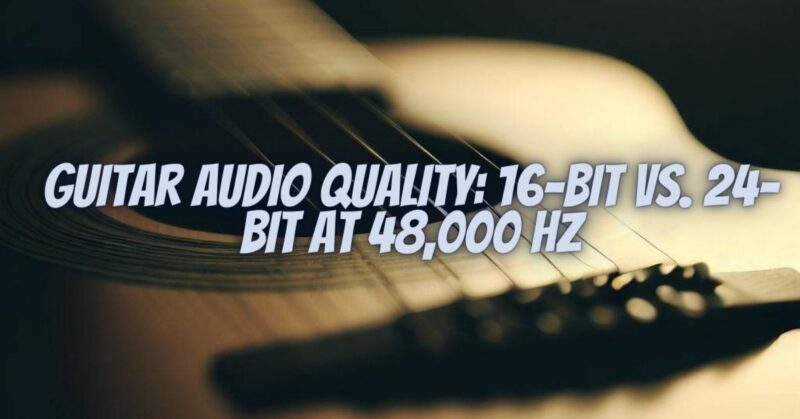When it comes to recording and producing music, the quality of audio is paramount. Musicians and audio engineers constantly strive for the best possible sound, and one critical aspect of achieving this is choosing the right bit depth and sample rate for their recordings. In the realm of guitar audio, the debate often centers around 16-bit vs. 24-bit audio at a sample rate of 48,000 Hz (48 kHz). This article will delve into the intricacies of these two formats, their impact on guitar recordings, and help you make informed decisions about which one suits your needs best.
Understanding Bit Depth and Sample Rate
Before we dive into the comparison between 16-bit and 24-bit audio at 48 kHz, it’s essential to understand what bit depth and sample rate mean and how they influence audio quality.
Bit Depth: Bit depth refers to the number of bits used to represent each sample of audio. In a 16-bit system, there are 16 bits for each audio sample, allowing for 65,536 possible values (2^16). A 24-bit system, on the other hand, provides 16,777,216 possible values (2^24). A higher bit depth means greater precision in capturing the nuances of audio, resulting in a wider dynamic range and lower noise levels.
Sample Rate: Sample rate, measured in Hertz (Hz), determines how many audio samples are captured per second. A sample rate of 48,000 Hz means 48,000 individual samples are taken every second. Higher sample rates can capture more high-frequency detail but may result in larger file sizes.
16-bit Audio
16-bit audio is a common format used in many consumer audio devices, such as CDs. It offers a dynamic range of approximately 96 decibels (dB). For many music genres, including rock and pop, 16-bit audio can provide excellent quality when recorded and mixed properly. Most listeners may not discern any significant difference between 16-bit and higher bit-depth audio in such scenarios.
However, when it comes to guitar recordings with a wide dynamic range, such as acoustic fingerpicking or electric guitar solos with soft and loud passages, the limitations of 16-bit audio can become apparent. In such cases, the lower bit depth may result in audible quantization noise, especially in quiet passages where the nuances of the guitar performance may be lost.
24-bit Audio
24-bit audio, with its significantly higher dynamic range of around 144 dB, is often considered the professional standard for recording and mixing. This format can capture the most delicate details and the loudest peaks of a guitar performance with incredible precision. It provides ample headroom, reducing the risk of clipping or distortion during recording, and allows for more flexibility in post-production.
When working with 24-bit audio, guitarists and engineers have greater freedom to manipulate the sound during mixing and mastering without introducing artifacts or compromising quality. This is especially beneficial for genres that demand a wide dynamic range, such as classical or jazz guitar music.
Sample Rate: 48,000 Hz
The choice of sample rate, such as 48,000 Hz, also plays a role in guitar audio quality. In general, 48 kHz is considered a standard sample rate for music production, offering a balance between audio quality and file size. It captures frequencies up to 24 kHz, which is well beyond the range of human hearing.
While some argue for even higher sample rates, such as 96 kHz or 192 kHz, for the potential to capture ultrasonic frequencies and increased audio quality, the audible benefits are often debated. In most cases, a 48 kHz sample rate provides more than enough fidelity for guitar recordings and is widely compatible with various audio equipment and platforms.
Conclusion
In the debate of 16-bit vs. 24-bit audio at a 48,000 Hz sample rate for guitar recordings, the choice ultimately depends on your specific needs and goals. Here are some key takeaways:
- 16-bit Audio: Suitable for many musical genres and situations where the dynamic range isn’t extremely wide. It can deliver high-quality results when used thoughtfully but may exhibit limitations in complex guitar performances.
- 24-bit Audio: Preferred for professional recording and mixing, especially when dealing with demanding guitar performances with wide dynamic ranges. It offers superior precision, headroom, and flexibility during production.
- 48,000 Hz Sample Rate: A common and practical choice for capturing guitar audio. It balances audio quality and file size, making it suitable for most musical applications.
Ultimately, the best choice for your guitar recordings depends on your specific project, equipment, and artistic vision. Consider the dynamic range of your performance, the intended genre, and your available recording and processing capabilities when making this critical decision. With the right bit depth and sample rate, you can ensure that your guitar recordings capture every nuance and deliver the best possible audio quality.


